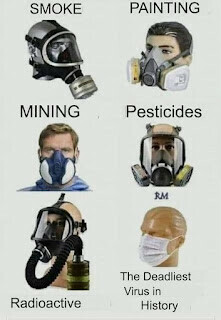
The Montana Department of Health emphatically writes in bolded letters that N95s that seal are the only things that might help against smoke particles (which are around 1 micron, 10 times larger than most viral virions), but warns of health risks. “Note that respirator masks should be a last resort, as they are difficult to fit correctly, decrease oxygen intake, are hot, and can easily leak when worn improperly.” They go on to add, “People who are not physically fit may experience difficulty going about daily tasks due to reduced oxygen intake. It is more important to have enough oxygen than to have clean air - if you are using a respirator and feel faint, nauseous, or have trouble breathing, take the mask off.”
On the Washington Department of Health’s website guidance for wildfires, it is made clear that “masks are not approved for children” and that “it is harder to breathe through a mask, so take breaks often if you work outside.” The Sacramento County Department of Health Services states, “N95 respirator can make it more difficult for the wearer to breathe due to carbon dioxide buildup, which reduces the intake of oxygen, increased breathing rates, and heart rates.”
Just a year ago, CDC Director Rochelle Walensky swatted down the idea of wearing N95s. “They’re very hard to breathe in when you wear them properly,” Walensky said. “They’re very hard to tolerate when you wear them for long periods of time.”
Thus, whether we are talking about masks or N95s, it’s quite evident that they are either unsafe or ineffective. They can often be both unsafe and ineffective, but they can never be effective without being unsafe, unless worn by the right person with the right training in limited environments for short periods of time.

P4L
N95 makers were not making the money they thought they would so now............ Anyone CAN put one on. But making users wear them correctly.........................?
I have worn respirators most of my life. From working on the farm, to hazmat.
If you are not fitted for a respirator, they may not provide protection. Even if you are, if you are not trained on donning and doffing, it isn’t going to work.
For several locations I had to use a respirator for particulate protection. Particulates are small particles of material, several orders of magnitude larger than viruses.
For silica dust, N95’s were explicitly banned as not being tight enough. We had to use N100, often in stages, and half or full face respirators. If you wear one of these and have reduced lung capacity, you will pass out or die. If you have facial hair, you will not have a good seal.
I could go on.
A joke in Hazmat is in dealing with an acid atmosphere, you will know where the leaks are.
If they aren’t fit tested, they are worthless.
Before I retired, I had to wear one in certain departments, sometimes all day, because of dangerous chemicals. We were trained on wearing and fitting them and had to remove them every two hours. Depending on the department, sometimes we had to use a new one every two hours. Some departments required air packs with tanks worn on the back and an enclosed helmet. I didn’t work in those departments. With my asthma, I wasn’t allowed near them.
ping
I don’t consider an N95 mask to be a respirator. All of us that use then in a trade call them Dust Masks. I believe up until 2020, 3M called them particulate masks.
Spray painters wear respirators with silicone frame for an air tight against the face and replaceable filter cartridges.
N95 works as well on the Fauci Virus as a tennis racquet works for shoveling sand.
OSHA requires a pulmonary function test if you are going to wear a respirator for work. N95 masks are considered respirators.